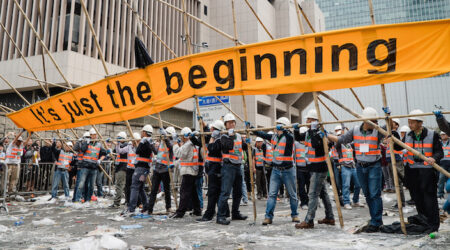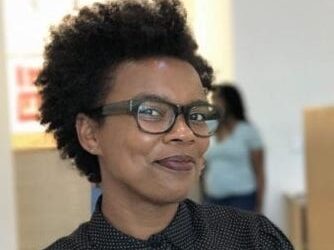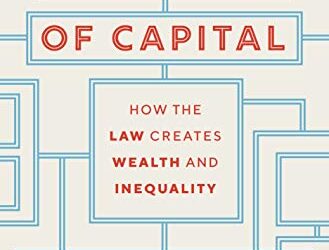On October 7, 2020, Social Science Matrix hosted an online discussion focused on Black in Place: The Spatial Aesthetics of Race in a Post-Chocolate City, a book authored by Brandi Thompson Summers, Assistant Professor of Geography and Global Metropolitan Studies at UC Berkeley. In her book, Summers documents Washington, D.C.’s shift to a “post-chocolate” cosmopolitan metropolis by charting the economic and racial developments of H Street, one of the city’s main commercial corridors. Thompson’s book offers a theoretical framework for understanding how blackness is aestheticized and deployed to organize landscapes and raise capital.
Dr. Summers discussed Black in Place with Nikki Jones, Professor in the Department of African American Studies at UC Berkeley, as part of the Social Science Matrix “Authors Meet Critics” series, which features critically engaged discussions about recently published books by social scientists at UC Berkeley.
Jones noted at the outset, however, that “Authors Meet Critics” was an inappropriate title for the conversation. “[Authors meet critics] is standard fare in the academy, we know that,” Jones said. “But it represents a particular way of producing and consuming knowledge, and it doesn’t always align with the Black feminist politics that I like to bring into the space or even Black feminist modes of critique…. I show up in this space not as a critic of what has been thoughtfully and carefully produced, but as a co-constructor of knowledge, as a person who has engaged with your work and your ideas, and is poised to engage with you around those ideas, and others who are able to join us today, to also learn from that conversation.”
Summers began the discussion by providing an overview of her book’s central focus. “I’m really describing this changing historical role of Blackness and its interaction with processes of gentrification,” she explained. “I’m using this small space — H Street, this commercial corridor — to tell a much wider story about cultural change, about racial conflict, and also about capital flows and governance…. I wanted to take this hyperlocal focus because I think you’re better able to see the the nuances and the patterns that hold narratives together. And you can better see the inner workings of power when you look at a small geography, and unpack various elements that contribute to the production and the management of space.”
“It perfectly illustrates this problem that emerges when Black areas are essentially primed for revitalization,” she added. “I’m using Blackness as this central analytic to really understand how racism shapes Black life and, and how these liberal proclamations of ‘race neutrality’ or these calls for diversity only serve to marginalize and ultimately displace Black people.”
Summers explained that she coined the term “Black aesthetic emplacement” (BAE) as a way to think about how Blackness is “deployed to fortify public order and organize landscapes literally, as well as foster capital. This happens through this hegemonic capitalist structuring and a signifying of ideas about Blackness to really increase the desirability of coming to a particular neighborhood, or coming to the city. I don’t mean Black aesthetics as in Black cultural production. I’m thinking about Black aesthetics separately, where Blackness operates as an aesthetic that’s essential to gentrification as an urbanizing process, and can really be seen clearly in institutions that provide daily life or daily service.”
“The urban landscape is being produced in ways that necessitate the visibility of Blackness, but also operate alongside the displacement of Black people and those enterprises that cater to poor and working-class Black residents,” Summers said. “In the book, I’m trying to document these these everyday expressions of the symbolic takeover of Blackness…. The transformation of H street really exemplifies this dismantling of the Black city. It’s this disappearing mode of social and cultural life that’s been revised and and remade by this aesthetic infrastructure.”
The book shows us how a city becomes cool through Blackness, even as the population of Black people in the city declines.
In her comments, Jones praised how Summers uses the transformation of the H Street corridor to expose the story of race and gentrification, and noted that, as a sociologist, she likely would have taken a different approach. “I appreciate the way that space is the main character, the key respondent in this book,” Jones said. “I focus on on interpersonal interaction, so I simply would not would not have done the thing you do here quite masterfully, which is to make spatial relationships — the relationship between space and capital, and in turn the relationship between space, Blackness, and capital — a main point of entry into the story of H Street.”
“Sociologists can take space for granted,” Jones said. “In not taking space for granted, you create a way of seeing relationships — structural, economic, and social — that exist but aren’t accessible solely through the tools or training of social science generally. And in doing so, you provide a model not for the one way to see Blackness in the city, but a multiplicity of ways to see Blackness, and to see Black people in spaces where they are necessary, yet unseen.”
“Blackness is made to be seen in the city in ways that are increasingly untethered from the visual presence of actual Black people, untethered from Black life as it is lived, as you argue, in a place where blackness operates on the level of aesthetics.
Jones pointed to one of the examples described in Summers’ book — Chocolate City Beer, a (now defunct) craft brewery owned by two White men that used the Black power fist in its logo — to highlight “how ‘Blackness shows up in the city — Blackness as taste, Blackness as struggle, Blackness as nostalgia. Blackness acts as an engine of profit. Blackness is ‘the illusion of inclusion within the culture of modern capital’…. The book is a history of how post-racial discourse in neoliberal urban development converts Blackness into a prized aesthetic. The book shows us how a city becomes cool through Blackness, even as the population of Black people in the city declines.”
Watch the video of the discussion above or on YouTube.


